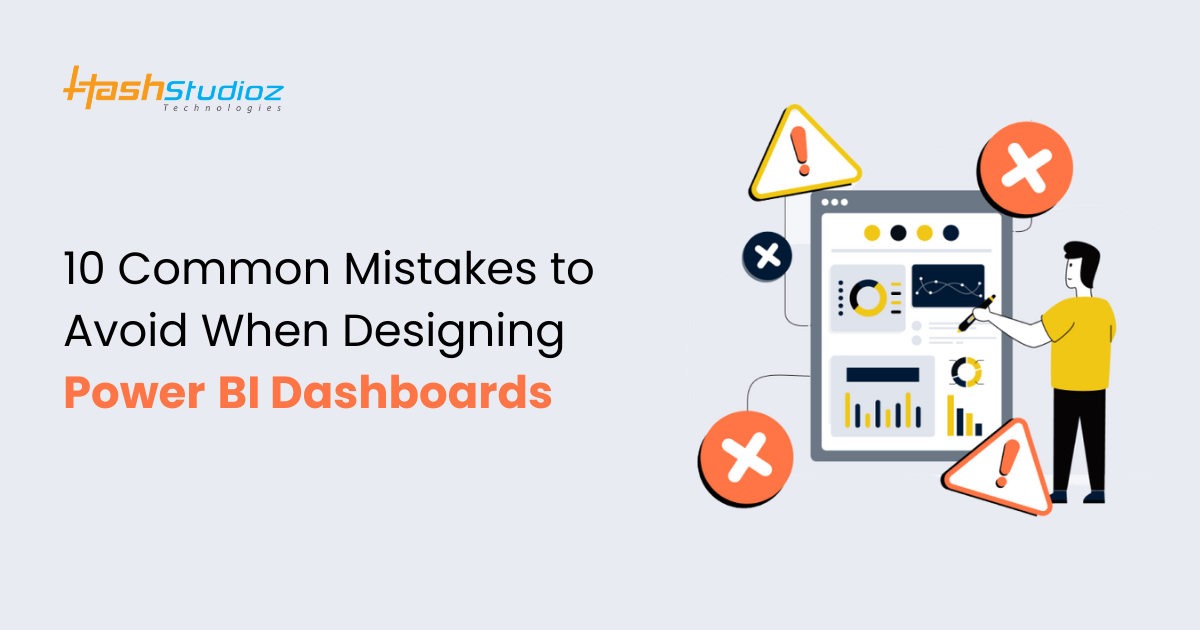Designing Power BI dashboards is an art and science that combines data representation, user experience, and business intelligence. However, many businesses struggle to create impactful dashboards due to avoidable design mistakes. Whether you are part of a Data Analytics Services Company or planning to Hire Data Analyst professionals, understanding these common pitfalls is crucial to delivering compelling insights. This article explores 10 common mistakes to avoid and provides practical solutions for creating effective dashboards.
- Over 65% of organizations rely on dashboards for decision-making.
- 70% of dashboards fail due to poor design or unclear objectives.
- Companies using effective Data Analytics Solution frameworks report a 23% improvement in data utilization.

Table of Contents
- 1. Overloading the Dashboard with Data
- 2. Neglecting User Needs
- 3. Poor Visual Selection
- 4. Ignoring Data Refresh and Accuracy
- 5. Lack of Interactivity
- 6. Inconsistent Design Standards
- 7. Failing to Optimize for Performance
- 8. Overlooking Mobile Optimization
- 9. Missing Contextual Information
- 10. Skipping Testing and Feedback
- Why Choose HashStudioz for Power BI Dashboards?
- Conclusion
- FAQs
1. Overloading the Dashboard with Data
Why It Happens:
Designers often attempt to present all data in a single dashboard, assuming that more data equals better insights.
The Problem:
Overloading leads to cluttered visuals, making it difficult for users to focus on critical metrics. Decision-makers may struggle to identify actionable insights.
How to Avoid:
- Focus on key performance indicators (KPIs) relevant to your audience.
- Use filters and drill-through options to allow users to explore additional data without overwhelming them.
- Group related data into sections or create separate dashboards for different purposes.
2. Neglecting User Needs
Why It Happens:
Designers sometimes prioritize aesthetics or personal preferences over user requirements.
The Problem:
If the dashboard does not cater to the target audience, it will fail to deliver value. For example, a financial team may need detailed metrics, while executives require high-level summaries.
How to Avoid:
- Conduct stakeholder interviews to understand their needs.
- Create personas to guide the design process.
- Incorporate iterative feedback to ensure the dashboard aligns with user expectations.
3. Poor Visual Selection
Why It Happens:
Choosing visuals based on aesthetic appeal rather than suitability for the data.
The Problem:
Improper visuals can lead to misinterpretation. For instance, using pie charts for complex data comparisons can confuse users.
How to Avoid:
- Match visuals to data types. Use bar charts for comparisons, line graphs for trends, and heatmaps for density.
- Limit the use of decorative visuals that do not add value.
- Follow Power BI best practices for visualizations to ensure clarity.
4. Ignoring Data Refresh and Accuracy
Why It Happens:
Designers may overlook the importance of real-time or periodic data updates.
The Problem:
Outdated or inaccurate data undermines the credibility of your dashboard and leads to flawed decision-making.
How to Avoid:
- Set up automated data refresh schedules.
- Validate data sources and perform regular data quality checks.
- Test data connections to ensure reliability.
5. Lack of Interactivity
Why It Happens:
Some designers create static dashboards, underestimating the value of user interactivity.
The Problem:
Static dashboards limit user exploration and hinder insights. Interactive features like slicers, tooltips, and drill-throughs enhance user experience.
How to Avoid:
- Use slicers and filters to enable users to customize their views.
- Implement drill-through options for deeper analysis.
- Add tooltips to provide additional context without cluttering the visuals.
6. Inconsistent Design Standards
Why It Happens:
Inconsistent fonts, colors, and layouts result from unstructured design processes.
The Problem:
Inconsistent designs confuse users and reduce the dashboard’s professional appearance.
How to Avoid:
- Create and adhere to a style guide outlining font sizes, color schemes, and layout rules.
- Use Power BI themes to maintain consistency.
- Test the design for visual harmony across all devices.
7. Failing to Optimize for Performance
Why It Happens:
Large datasets and complex calculations can slow down dashboard performance.
The Problem:
Slow-loading dashboards frustrate users and reduce productivity.
How to Avoid:
- Optimize data models by removing unnecessary columns and tables.
- Use aggregations and calculated columns sparingly.
- Monitor and improve query performance using Power BI’s Performance Analyzer.
8. Overlooking Mobile Optimization
Why It Happens:
Designers often forget that dashboards are frequently accessed on mobile devices.
The Problem:
Dashboards that are not mobile-friendly result in poor user experiences for on-the-go users.
How to Avoid:
- Use Power BI’s mobile layout feature to design mobile-friendly dashboards.
- Test dashboards on multiple devices to ensure usability.
- Prioritize key visuals and metrics for mobile views.
9. Missing Contextual Information
Why It Happens:
Assuming users will inherently understand the data presented.
The Problem:
Without labels, titles, or explanations, users may misinterpret the visuals.
How to Avoid:
- Add clear titles and labels to all visuals.
- Provide brief descriptions or instructions where needed.
- Include legends and tooltips to enhance understanding.
10. Skipping Testing and Feedback
Why It Happens:
Rushing to deploy dashboards without thorough testing or user feedback.
The Problem:
Undetected errors and overlooked user needs can lead to dashboard failure.
How to Avoid:
- Test dashboards with a small user group before full deployment.
- Gather feedback and iterate based on user input.
- Regularly update dashboards to align with evolving business needs.
Why Choose HashStudioz for Power BI Dashboards?
Why Choose Us?
HashStudioz is a trusted Data Analytics Services Company offering customized Power BI solutions to turn raw data into actionable insights.
Key Reasons to Choose HashStudioz:
- Expertise in Data Analytics: Skilled professionals delivering tailored, scalable dashboards.
- User-Focused Design: Interactive layouts focused on KPIs and usability.
- Seamless Integration: Connect multiple data sources for real-time insights.
- End-to-End Support: From development to optimization and updates.
- Security & Compliance: Advanced protection with row-level security (RLS) and compliance standards.
- Mobile Optimization: Access dashboards anytime, anywhere.
How HashStudioz Helps You with Power BI Dashboards
- Dashboard Development: Custom, visually rich designs for better decisions.
- Data Integration: Streamlined data from multiple sources for accuracy.
- Performance Optimization: Faster queries and real-time reporting.
- Interactive Features: Filters, slicers, and drill-throughs for dynamic exploration.
- Training & Support: Ensure your team leverages dashboards effectively.

Conclusion
Designing effective Power BI dashboards requires avoiding common pitfalls such as clutter, poor visuals, and inconsistent design. By focusing on user needs, ensuring data accuracy, and incorporating interactivity, businesses can create dashboards that drive actionable insights.
Whether you are a Data Analytics Services Company or looking to hire a data analyst, following these best practices will enhance your data analytics solution and maximize the value of your dashboards.
FAQs
1. What are the most important elements of a Power BI dashboard?
The key elements of a Power BI dashboard include Key Performance Indicators (KPIs), visualizations (charts, graphs, and maps), filters, and navigation tools. These components work together to provide actionable insights, enabling users to monitor performance and make data-driven decisions effectively.
2. How can I improve the performance of my Power BI dashboard?
Improving performance involves optimizing data models by removing unnecessary columns, reducing query loads through aggregations, and enabling data caching. These steps enhance loading speeds and ensure a smooth user experience.
3. Should I use third-party tools with Power BI?
Yes, integrating third-party Data Analytics Solution tools can expand Power BI’s capabilities, offering advanced features like predictive analytics, data cleansing, and scalable storage options, improving overall functionality and efficiency.
4. How often should I update my Power BI dashboard?
Dashboard updates should align with business needs. Frequent updates—daily, weekly, or monthly—ensure data accuracy and relevance, especially for tracking real-time metrics or fast-changing trends.
5. Can I secure sensitive data in Power BI dashboards?
Yes, sensitive data can be protected using row-level security (RLS), which restricts access based on user roles. Additionally, compliance measures and data encryption ensure data privacy and regulatory adherence.

